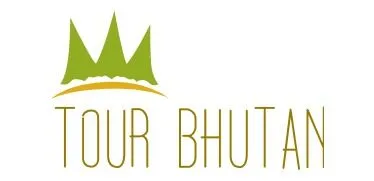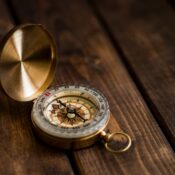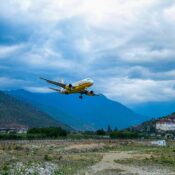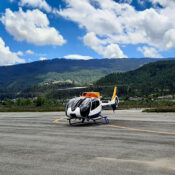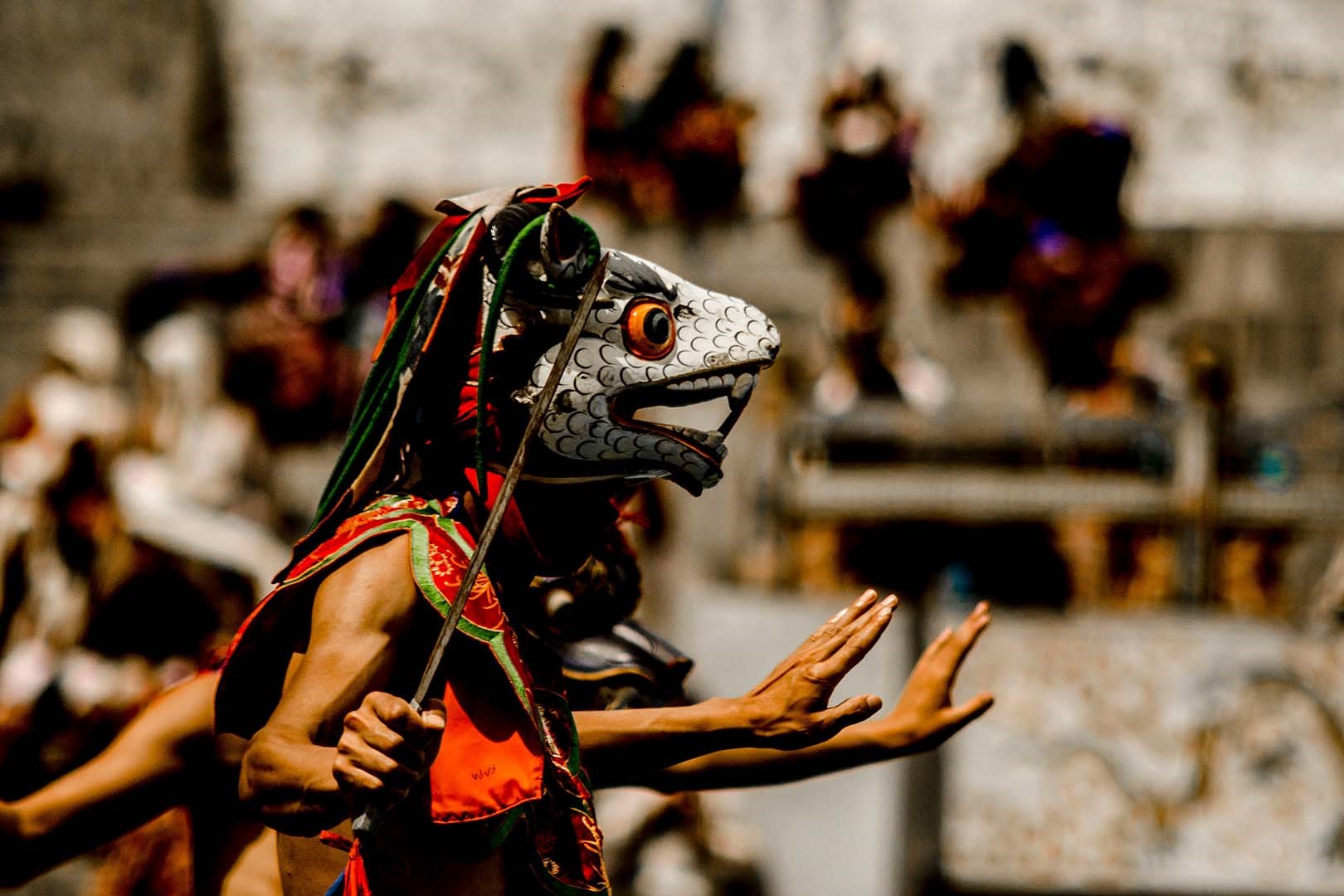Best Time to Travel Bhutan

Best Time to Travel Bhutan
Spring and autumn are the finest season to visit Bhutan. Though people can visit Bhutan all year, some tourists may have an unpleasant experience due to unforeseeable weather circumstances, which is why it is critical to know the optimum time to travel to Bhutan before booking your Bhutan tour package.
With 14 years of experience in the tourism business, we can promise you the ideal time to visit Bhutan. The busiest tourist seasons are from March to May and September to November and Bhutan is thought to be at its most beautiful during these months.
Bhutan is best visited in the spring and fall. The best season to hike and trek in Bhutan, as well as to discover the flora and wildlife of the Himalayas because of the vibrant foliage and fewer days of rain. Bhutan has a dry autumn with little raindrops, bright sunshine, and several brightly coloured festivities. It is the time of year when tourists may enjoy the country’s breathtaking scenery and hospitable environment.
It’s not that travellers can’t visit Bhutan during other months, even though we strongly advise organizing your trip at this time. They can, although the weather might not be ideal for capturing the country’s natural beauty and authentic Bhutanese character but Winter is substantially colder with temperatures below 0 degrees at night while Summer is typically rainy with regular showers. Even though it’s cold most evenings from December to February, the scenery is breathtaking. Bhutan experiences its annual snowfall at this season, which illuminates the surroundings with brilliant white snowflakes. If you prefer the winter, it can be one of the greatest times to visit Bhutan.
Which Month Is Best for a Bhutan Travel Experience?
The Country is open all year, but the nation endures varying weather patterns, making visiting difficult and severe. Summer and winter weather may be fairly harsh, making it difficult to adjust to the changes. Monsoon rain creates landslides and causes flights to be cancelled and rescheduled.
Winters are mild yet chilly, with temperatures dropping below zero degrees and Roads might become hazardous as ice forms, but there are lots of places to visit to enjoy the chill. We guarantee the ideal months’ weather charts, festivals, and tours program to help you plan your future Bhutan Tour in 2023.
Bhutan Visit in Spring (March, April and May)
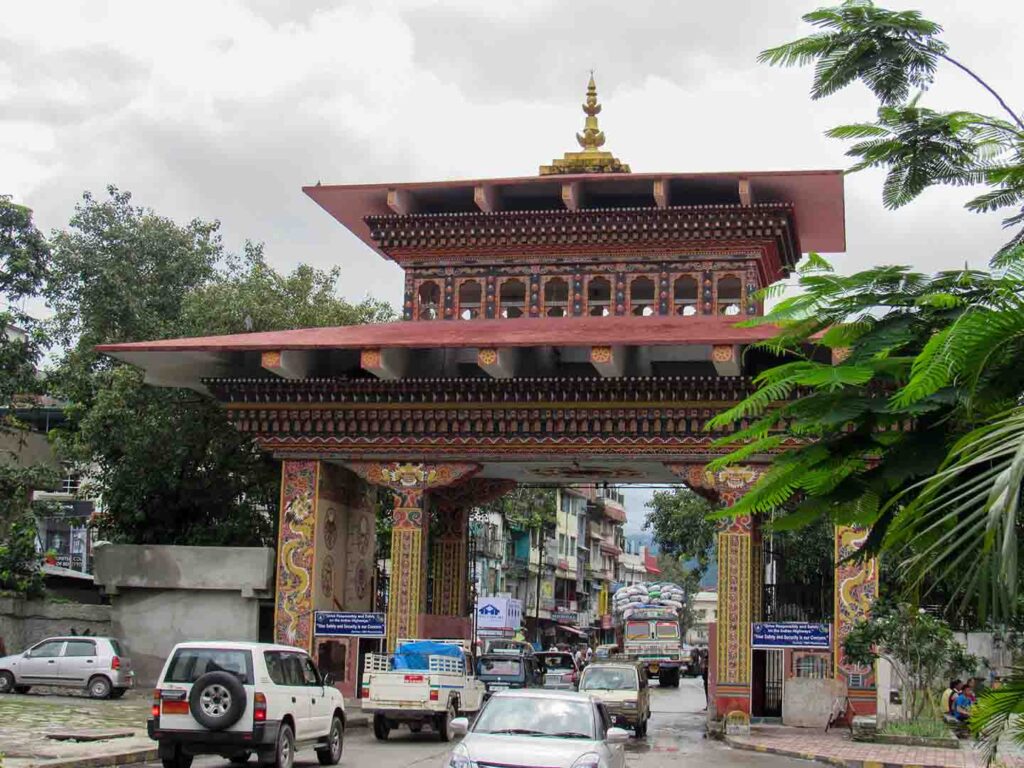
The finest time to visit Bhutan is in the spring since the weather is quite pleasant. It is likely the greatest time to visit Bhutan because the weather is dry and less humid, providing ideal circumstances for exploring the country on foot, participating in hiking activities, and attending famous festivals.
Spring Climates in Bhutan
It’s a country in South Asia, located in the eastern Himalayas. The climate in Bhutan varies depending on the altitude and the season.
In general, spring in Bhutan is Bhutan’s Peak Season to travel Bhutan. A very pleasant time of the year, with mild temperatures and relatively dry weather. The spring season in Bhutan lasts from March to May, and during this time, the weather is usually warm and sunny, with temperatures ranging from 15°C to 25°C in the valleys and lower elevations. At higher elevations, the temperatures can still be cool, and there may be occasional snowfall or frost.
In March and April, the country experiences a beautiful display of rhododendrons, cherry blossoms, and other colourful spring flowers, making it an ideal time for nature lovers and photographers. The valleys and hills are lush green, and the rivers and streams are full of water, making it a great time for outdoor activities like trekking, hiking, and rafting.
However, it is important to note that the weather in Bhutan can be unpredictable and may vary from year to year. It is advisable to check the weather forecast before planning a trip to Bhutan during the spring season
Autumn in Bhutan
The fall season lasts from September through November. Bhutan enjoys the most festival celebrations at this time of year. Autumn casts a beautiful golden glow over the wide terrain and is one of the busiest seasons for travellers visiting Bhutan. Under the beautiful blue sky, rice fields mature to a golden brown in the fall and cosmos flowers, in cheerful pink and white, adorn the landscape.
Climates in Bhutan
Climates differ greatly depending on elevation. Southern Bhutan is warmer than the rest of the country. Semi-tropical climates with cold winters prevail in places like Punakha, Wangdiphodrang, Mongar Trashigang, Trongsa, and Lhuntse. Whereas Haa, Paro Thimphu, Tashi Yangtse, and Bumthang have cooler climates, with some of these areas covered in light snow. Only in the High Himalayan area (northern section of the country) is snow present all year. During the monsoon season, strong rains fall practically every night, therefore a raincoat or an umbrella is essential.
Thimphu’s Average Rainfall and Temperature in a Year
The information on Bhutan Rainfall and Temperature is based on the Source provided by the National Center for Hydrology and Meteorology, the Royal Government of Bhutan.
Is January a good time to travel to Bhutan?
We are still in winter, with temperatures below 0 degrees. Due to the chilly winter season in the kingdom, some may believe that travelling to Bhutan in January is a terrible decision. And, indeed, the month is quite cold, with temperatures ranging from 0 to 12 degrees during the day and -3 to -10 degrees at night. Snowfall is common in Bhutan’s northern regions.
Only a few visitors visit in January because there are less tourists, you may explore the attractions without having to wait in line. If you detest large crowds and wish to experience Bhutan without being bothered, book your Bhutan visit in January. The sky is clear, allowing you to take in Bhutan’s breathtaking splendour.
Heavy snowfalls are uncommon in Bhutan, but if you’re lucky, you could get to see them in Thimphu, Paro, and Bumthang this month. , it is an excellent time to visit Bhutan if you want to avoid crowds and can tolerate the cold but if you wish to avoid the cold, visit in the spring or fall when the temperature is significantly milder.
What to wear in Bhutan in January 2025?
January is the winter season in Bhutan, and the weather can be quite cold, especially in the higher elevations. The temperature in Bhutan during this time can range from -5°C to 15°C, depending on the location and altitude. Here are some tips on what to wear in Bhutan in January:
- Layers: It is important to wear layers of clothing, as temperatures can fluctuate throughout the day. Start with a base layer of thermal or long-sleeved shirts and pants, followed by a warm sweater or fleece, and a thick jacket or coat.
- Winter accessories: Bring a warm hat, gloves, and scarf to keep yourself warm. It is also a good idea to wear thick socks and waterproof shoes or boots.
- Traditional dress: If you plan to visit temples or attend cultural events, it is respectful to wear Bhutanese traditional dress, which is warm and comfortable. Men can wear a gho, which is a knee-length robe, and women can wear a kira, which is a long skirt.
- Warm pyjamas: Make sure to bring warm pyjamas for sleeping, as temperatures can drop significantly at night.
- Sun protection: Despite the cold weather, the sun can still be strong in Bhutan. Bring sunglasses, a hat, and sunscreen to protect yourself from the sun’s rays.
Overall, it is important to dress warmly and comfortably in Bhutan during the winter season, especially if you plan to spend a lot of time outdoors.
List of Low altitude Trekking in Bhutan in January
- Gangtey Trek starts from Phobjikha and ends at Tikke Zam
- Samtengang Trek starts from Punakha and ends at Chizomsa
- Punakha Winter Trek starts at Dechencholing and ends at Rimchu

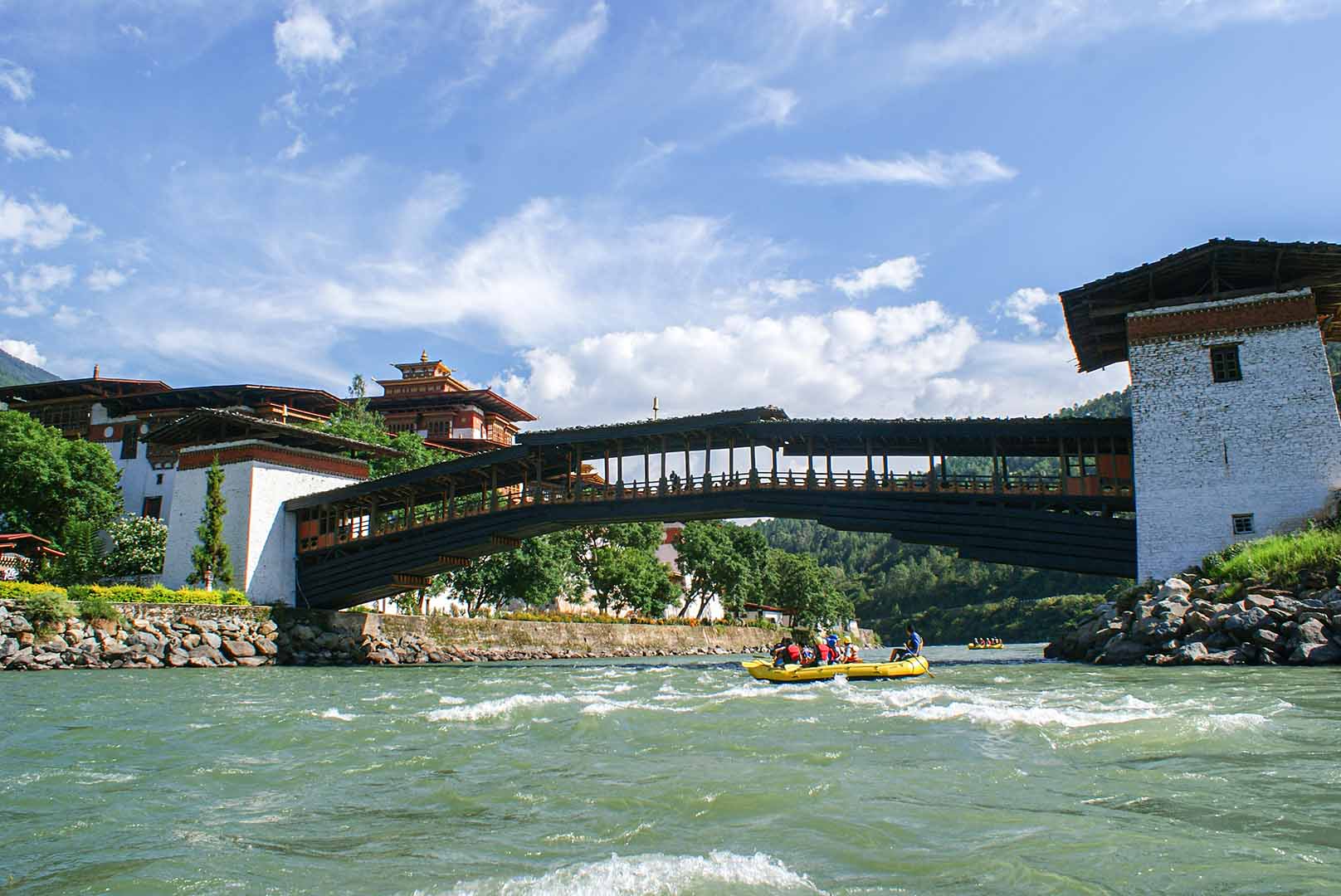
Bhutan Festival in January 2025
Our country is deeply religious, with several religious festivals held throughout the year. Witnessing the many festivities held in Bhutan is one of the key draws for travellers. During January, you may attend the Nyilo celebration, which commemorates the winter solstice. “Nyilo” literally means “the return of the sun,” and it is the day when the length of daylight rises, signalling the beginning of longer days. Traditional Bhutanese belief was that on Nyilo, previous mistakes may be erased and the karmic worth of good actions could increase.
Bhutan Temperature in January
The temperature drops in Northern and Southern Bhutan as January month is the peak winter in Bhutan. Please find the temperature in January.
- Phuntsholing High Temperature 23.9 Degrees and Low at 16.2 Degrees.
- Thimphu’s High Temperature at 14.6 and its Low at -3.3.
- Paro High Temperature at 12.8 Degrees and Low at 1.4 Degrees.
- Wangdiphodrang is high at 17.8 Degrees and Low at 5.5 degrees.
- Punakha is high at 17.5 Degrees and Low at 5.8 degrees.
- Bumthang is High at 11.0 degrees and low at -4.0 degrees.
Is Bhutan Ideal Time to Visit in February 2025?
February is still the winter season in Bhutan, and the weather can be quite cold, especially in the higher elevations. However, visiting Bhutan in February can also have its advantages.
One of the main advantages of visiting Bhutan in February is that it is considered a low season for tourism, which means that there are fewer tourists around. This can make it easier to get permits for popular attractions and to find accommodations at lower prices.
Additionally, the weather in Bhutan during February is usually dry and clear, with little rainfall. This can provide great opportunities for clear views of the snow-capped Himalayan peaks and outdoor activities like trekking and hiking.
However, it is important to note that some trekking routes and higher altitude areas may still be closed due to snow and ice. It is also important to dress warmly and bring appropriate winter clothing and gear, as temperatures can drop significantly.
Overall, if you are looking for a quiet and peaceful time to visit Bhutan and don’t mind the cold weather, then February can be a good time to go. Just make sure to plan and check the weather and travel conditions before your trip.
This time of the year offers plenty of sunlight and clear skies, favourable for photography and birding tours. It is not that cold during the day, but the temperature falls to freezing point during the night due to which we offer various discounts during December, January and February. Snowfall is rare near the western and eastern regions during this time but you can expect lesser snowfall such as Thimphu and Paro.
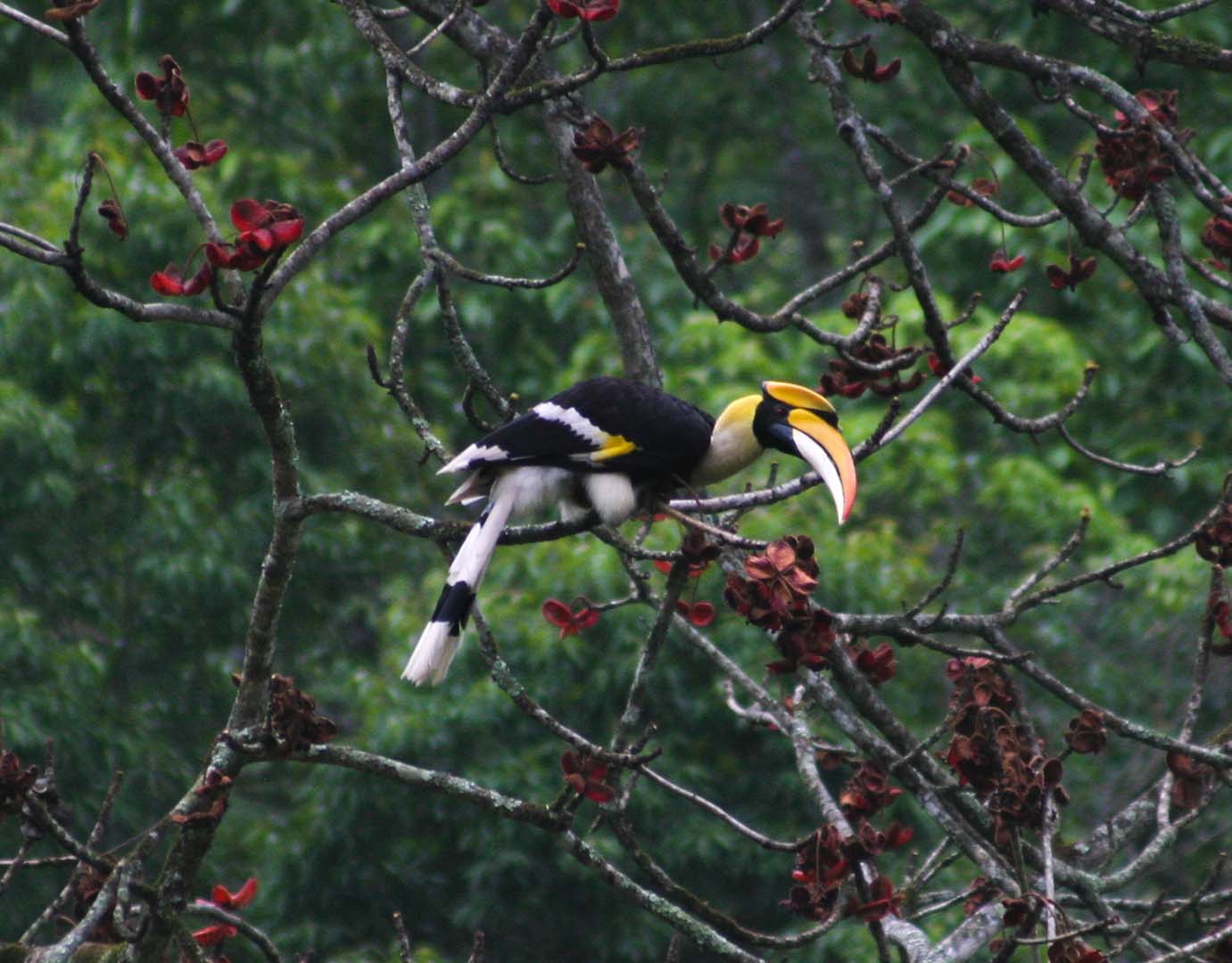
What to wear in February?
February is still the winter season in Bhutan, and the weather can be quite cold, especially in the higher elevations. Here are some tips on what to wear in Bhutan in February:
- Layers: It is important to wear layers of clothing, as temperatures can fluctuate throughout the day. Start with a base layer of thermal or long-sleeved shirts and pants, followed by a warm sweater or fleece, and a thick jacket or coat.
- Winter accessories: Bring a warm hat, gloves, and scarf to keep yourself warm. It is also a good idea to wear thick socks and waterproof shoes or boots.
- Traditional dress: If you plan to visit temples or attend cultural events, it is respectful to wear Bhutanese traditional dress, which is warm and comfortable. Men can wear a gho, which is a knee-length robe, and women can wear a kira, which is a long skirt.
- Warm pyjamas: Make sure to bring warm pyjamas for sleeping, as temperatures can drop significantly at night.
- Sun protection: Despite the cold weather, the sun can still be strong in Bhutan. Bring sunglasses, a hat, and sunscreen to protect yourself from the sun’s rays.
Overall, it is important to dress warmly and comfortably in Bhutan during the winter season, especially if you plan to spend a lot of time outdoors. It is also a good idea to bring a good quality backpack to carry your clothing, food and water while trekking or exploring.
What is Special about February?
Bhutan is not only gifted with beautiful landscapes and thick green forests but the country also celebrates never-ending festivals throughout the year. If you plan your Bhutan tour during February, you can join the following festivals.
Punakha Drubchen – Celebrated from 16th March – to 18th February 2025.
Venue – Punakha Dzong.
During this festival, we are showcased with a brief history of Punakha Dzong, conflicts, and problems faced by Zhabdrung during the construction of the Dzong for the visitors. Traditional mask dances are also performed by the central monastic body.
Punakha Tshechu– Celebrated from 19th – 21st February 2025.
Venue – Punakha Dzong. – It is one of the most popular festivals celebrated in the country, right after Punakha Drubchen where one can enjoy the beautiful mask dances and traditional folk songs sung by Bhutanese women. This particular date is also marked as the birth anniversary of Guru Rinpoche.
Tharpaling Thongdrol – Celebrated on 24th February 2025.
Venue -Tharpaling Lhakhang, Chumi, Bumthang.
The festival is only for one day and is mainly to display the enormous Thanka or Thongdrol. (Thanka/Thongdrol: meaning a professional silk work with Buddhist images that looks like a poster.) The Thankas are displayed every year alternatively (the 15th day) and the festival is celebrated with prayer ceremonials, performed by the monks of Tharpaling Lhakhang but no mask dances or cultural programs will be entertained during this time
What is it like to visit Bhutan in March?
The nation starts getting more visitors starting from this month. It is also the beginning of the spring season. Bhutan Weather and Temperatures can still be cool at night but during the day it is usually warm with sunny and clear skies and is favorable for outdoor activities like trekking and hiking.
The valleys are very beautiful due to new blooms and the temperature is perfect as well. Planning your Bhutan holiday in March can be a great idea for a warmer climate and weather. And no matter where you travel in Bhutan, be ready to be impressed by the scenic views of the country.
The weather and climatic conditions during March are very favourable in almost every part of Bhutan. Although there are differences in terrain and altitude, the temperature in the country has already started to rise. At the beginning of the month, humidity will be less and the vegetation will still be dry but we start to receive mild rainfall as well.
But in the southern region of Bhutan, the weather is hot during this time, with temperatures ranging from twelve to thirty degrees during the day but the rest of the regions in Bhutan have the perfect weather and climate conditions for touring and trekking. Paro Spring Festival in Bhutan is one of the attractions for tourists in March.
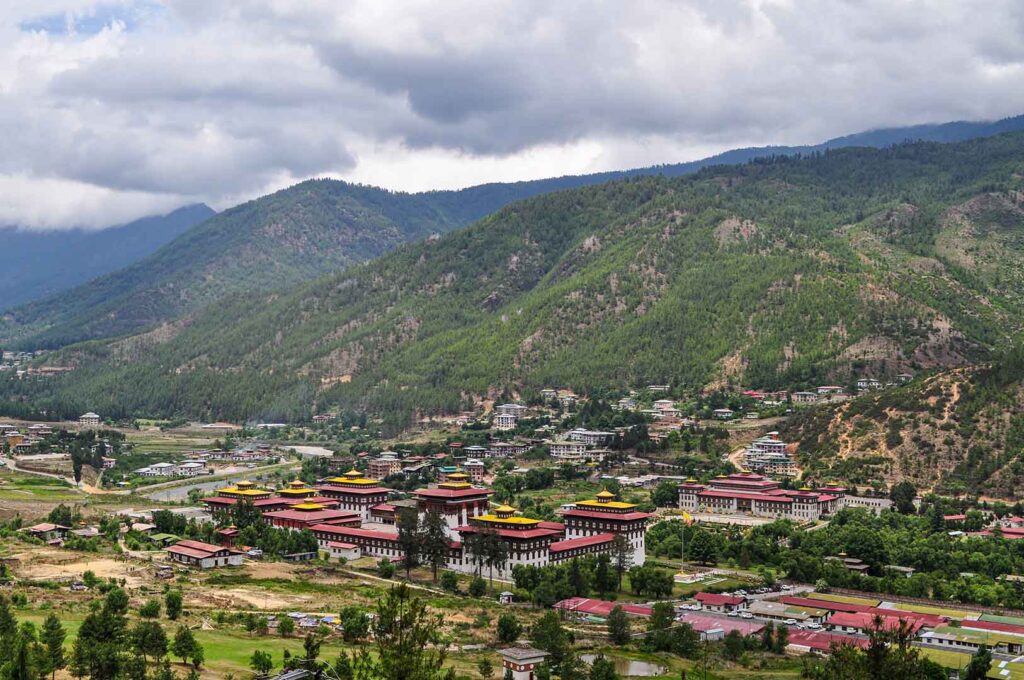
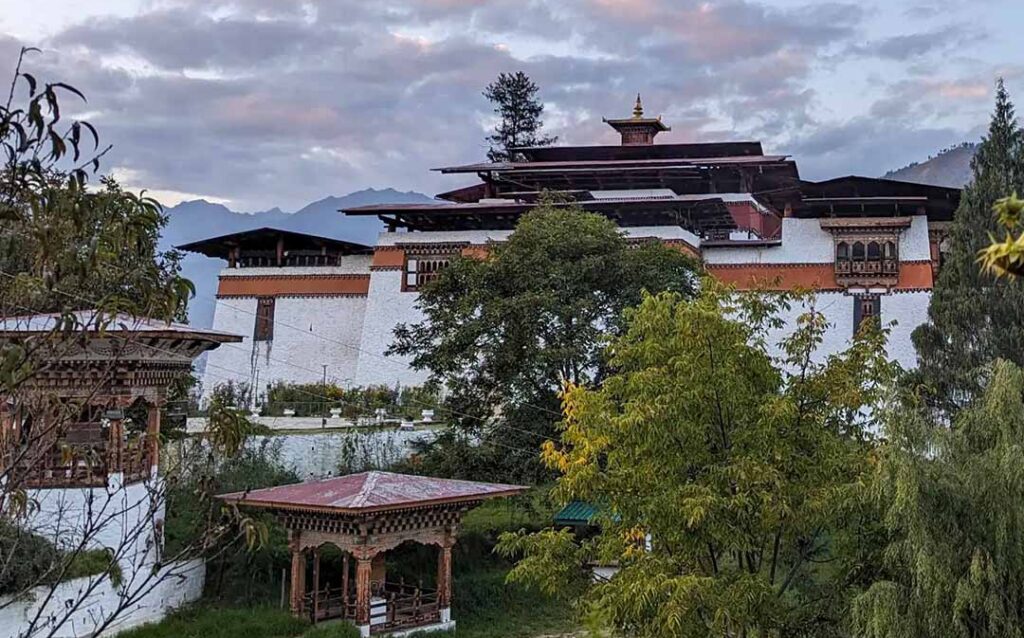
Bhutan’s Best Festival Tour in March
Other festivals you can combine with your Bhutan Tour in March are Paro Festival, Domkhar Tshechu, Chorten Kora, Buli Mani Festival in eastern Bhutan, Gasa Festival, Zhemgang Tshechu, Talo Tshechu, and Gomkora Festival.
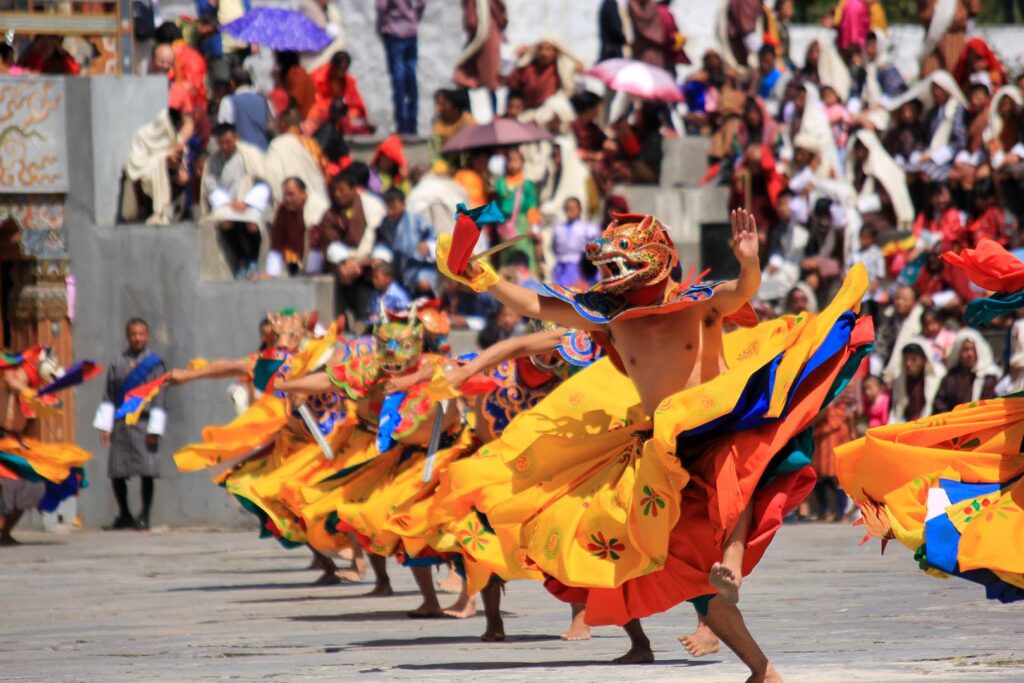
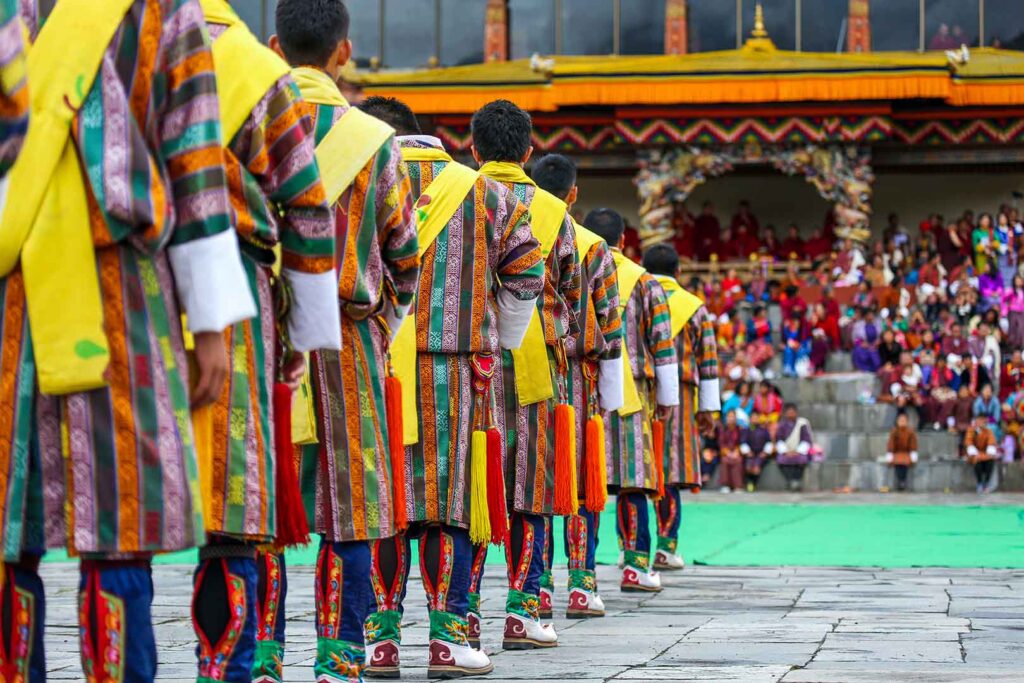
Find the best Trek you can Book in Bhutan for Spring
Trekking in Bhutan is guaranteed with clean and unspoiled trails. Spring is beautiful in Bhutan and trekking routes like Druk Path Trek, Dagala Thousand Lake Trek, and Dur Hot Spring Trek are the most popular Treks of Bhutan.
4 Best Places to Visit in Bhutan in March 2025
While Rhododendrons, wild azaleas and masses of wildflowers, including edelweiss, carpet the meadows. March heralds the botanical delight of spring and places like Paro, Thimphu, Bumthang, and Had have been a feast for the eyes.
- Paro: (altitude 1800-5400m) – The beautiful valley is home to many of Bhutan’s ancient monasteries and temples. The valley is also home to Mount Jumolhari (7,314 m), which is located at the northern end of the valley.
- Thimphu (altitude 1,800 m to 5,400 m): Thimphu is the capital of Bhutan and a bustling city on the shores of Wangchhu. It is home to the Bhutanese Royal Family, the Royal Government, and various foreign missions and development projects. Read More about Thimphu here.
- Bumthang (altitude 2,000m to 5,500m): The fascinating valley is the spiritual heart of the nation and home to some of the oldest Buddhist temples and monasteries. It is well known for the production of honey, cheese, apples, and Bumthang Mathra.
- Haa Valley (1000m to 5600m): The Haa Valley is blessed by the presence of Meri Puensum, three small mountains that symbolize Rigsum Gonpo. The valley is popular for apple and yak meat.
Things to Do in Bhutan in March 2025
Which Trekking can you do in Bhutan in March?
Some of the popular trekking you can do in March are as follows:
- Druk Path Trek is 5 days trek starting from Paro and ending in Thimphu.
- Jomolhari base Camp trek starting from Paro and ending at Paro.
- Dagala Thousand Lake Trek is one of the most beautiful Treks in western Bhutan.
- Trans Bhutan Trail is the most beautiful and recently introduced trail.
The month of March in Bhutan is ideal for Biking, Cycling, Birding, and River Rafting. Indoor activities such as wellness programs, spirituality, and yoga are some of the programs we recommend for spiritual clients.
March in Bhutan: Climate and Temperature
Bhutan is best visited in March because it marks the start of the spring season in Bhutan, bringing with it a slew of blossoms that add a dainty touch to the valleys with their pink and white blooms, as well as a sense of new wonder to the land.
- Phuntsholing High temperature at 29.5 degrees and 18.2 at Lowest.
- Paro High temperature at 17.6 and low at 5.6 Degrees.
- Thimphu High temperature at 18.2 degrees and as low as 3.0 degrees.
- Wangdue’s High temperature at 22.7 degrees and 10.8 degrees.
- Trongsa’s High temperature at 22.3 degrees and as low at 10.4 degrees.
- Punakha’s High temperature at 22.2 degrees and 11.2 degrees low.
- Bumthang’s High temperature at 14.8 degrees and 1.9 degrees low.
- Zhemgang’s High temperature at 16.6 degrees and 10.1 degrees low
Is April a suitable month to visit Bhutan?
An excellent month for trekking in Bhutan. Some of the most popular treks, such as the Jomolhari trek, Laya Gasa Trek, and cultural tours, are best done in April. Because April marks the beginning of the spring season, tourist traffic is higher during this month. Check Bhutan Tours Packages in April.
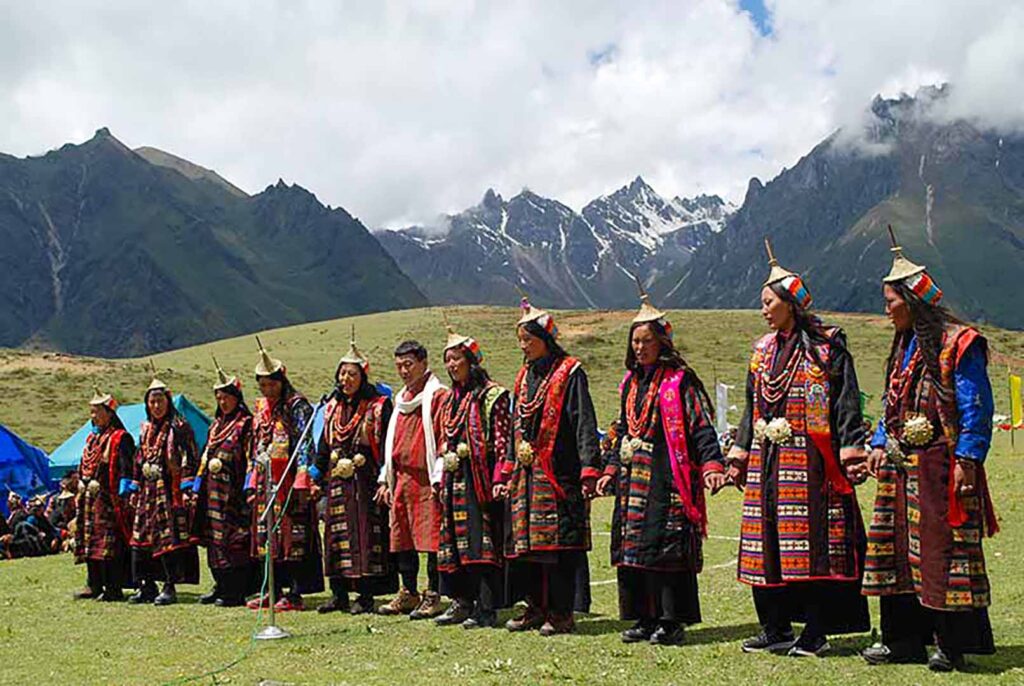
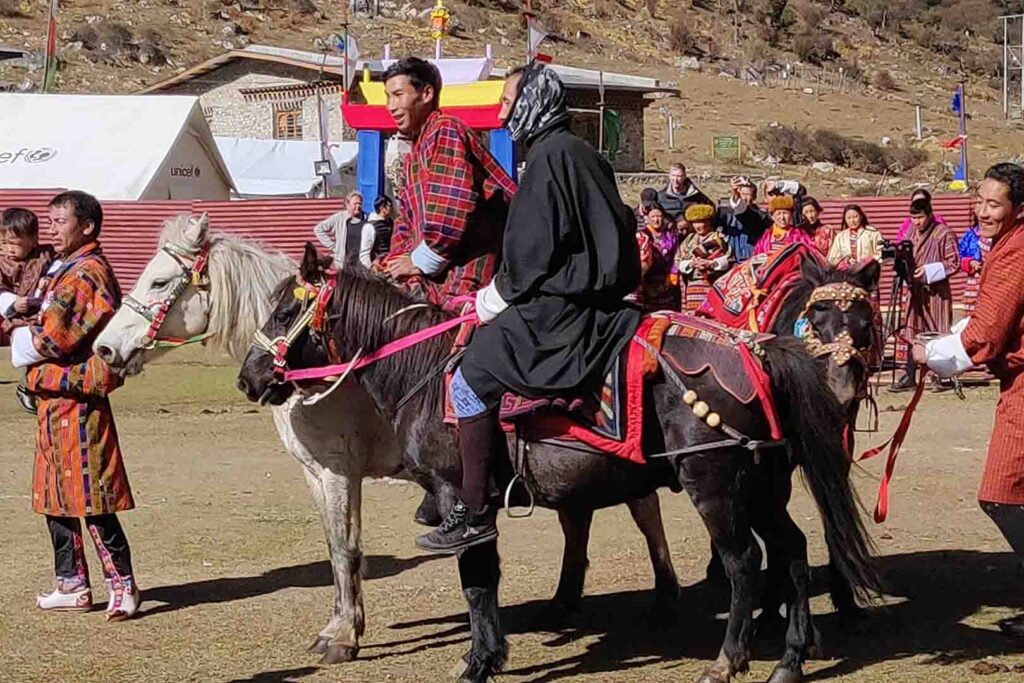
April 2024 will see the Popular Annual Bhutanese Festival
Rhododendron Festival- Held from April 14th to 16th, 2024. Venue: Lamperi Botanical Garden in Dochula, Thimphu. Read More.
Firstly the festival honours the rhododendron flowers, which grow abundantly in Bhutan. Second, include rhododendron garden walks and exhibitions, as well as cuisines, crafts, and traditional programs.
Domkhar Tshechu – Held from April 18th to 20th, 2024.
The festival lasts three days and features a variety of mask dances and cultural programs performed by Domkhar village residents.
Ura Yakchoe – Held from April 20th to April 24th, 2024.
Ura Lhakhang in Bumthang is the location.
The sacred mask dances, as well as other popular mask dances, are the main attractions of this festival because all of the dances are performed to honour a sacred relic that is shown to the people as a blessing.
Bhutan’s climate and weather in April
The weather is extremely pleasant. Most popular destinations, such as Thimphu, Punakha, Paro, and Wangdiphodrang, have warm weather during the day and cool weather in the evening.
The highest temperature in Paro is 25 degrees, and the lowest temperature is 17 degrees.
In Thimphu, the highest temperature was 24 degrees and the lowest was 16 degrees.
Punakha has a high of 32 degrees and a low of 23 degrees.
How should I dress for April in Bhutan?
April is a beautiful month to visit Bhutan, with sunny skies and little rain. Temperatures are warm during the day but cool at night. We recommend that you bring warm clothes in addition to your summer clothes. Thick jackets and sweaters are an option for the cold, but you don’t need to bring much with you. Sunglasses and hats can be very useful when the days are sunny and bright. And if you want to go on an adventure and trek the Himalayas, bring your trekking boots, warm jackets, and layers of warm clothing that you can remove when the temperature rises and becomes hot.
Bhutan’s Top Travel Destinations in May
Central Bhutan is the ideal location to visit in May since the weather and temperature stay cool with a clear blue sky. The finest destinations to visit are Thimphu, Paro, Punakha, Wangdi, and Bumthang.
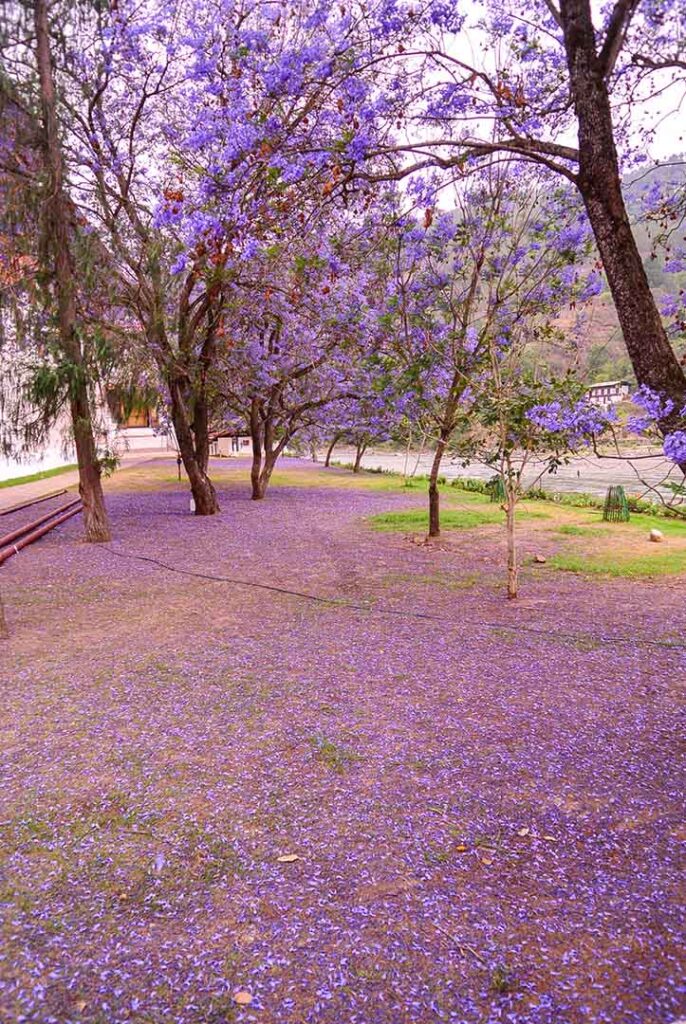
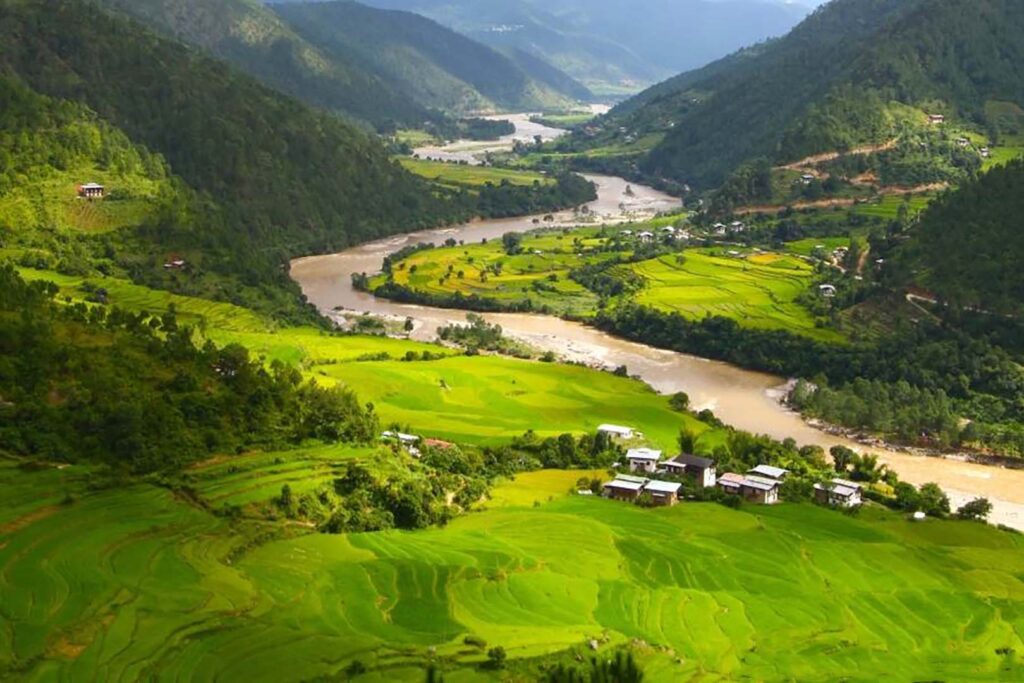
What can you do in Bhutan during May?
May is the peak season for Indians to visit Bhutan because the weather is very favourable for Cultural Tours, Birding, River Rafting, Hiking, and Low-altitude Trekking. You can combine these activities with festivals like Due Mang Ti in Zhemgang, Zobel Festival in Pemagatshel, and Bon Che Festival.
Things to Do in May
The weather is ideal for cultural tours, bird watching, river rafting, hiking, and low-altitude trekking. If you plan to visit and tour Bhutan in May, combine your visit with the Due Mang Ti Festival in Zhemgang, the Zobel Festival in Pemagatshel, and the Bon Che Festival.
We give you the greatest experience and reliable information for the aforementioned. To learn more about the latest information, get in touch with us.
Bhutan Travel: Is June a Good Month?
In Bhutan, the monsoon season begins in June. Though rainfall is abundant in southern Bhutan and areas such as Thimphu and Paro, Punakha (central Bhutan) receives very little rainfall. This makes early June a good time to visit Bhutan. Trekking is not recommended in June, July, and August owing to rain, although cultural excursions, day hikes, and visits to valleys and hills are possible.
What should be done in Bhutan in the long stretch of June
Booking national cultural excursions and low-altitude treks like the Druk Path Trek and the Jumolhari Base Camp Trek as well as certain popular trips like bird viewing, cycling, and river rafting in the nation, can still be best done in June.
Bhutan Travel Destinations in June
Bhutan’s central and southern regions make perhaps the best June travel destinations. The finest sites to visit are to explore the unique Bhutanese architecture in Thimphu, Paro, and Punakha.
The Dzongs, Monasteries, and traditional houses showcase the greatest Bhutanese architects. Traditional forms, colours, and patterns are distinctive. Traditional architects seldom plan and design on paper before constructing a project. There are no nails used, and the wood components are built using the dovetail process. Dzongs, temples, and bridges are excellent examples of traditional Bhutanese architecture.
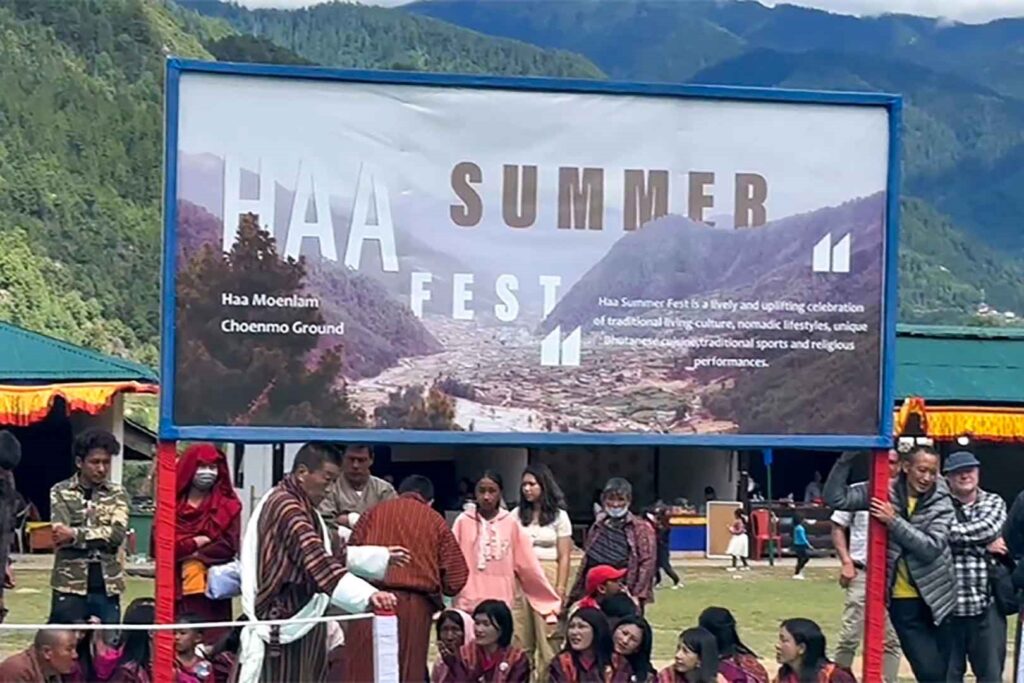
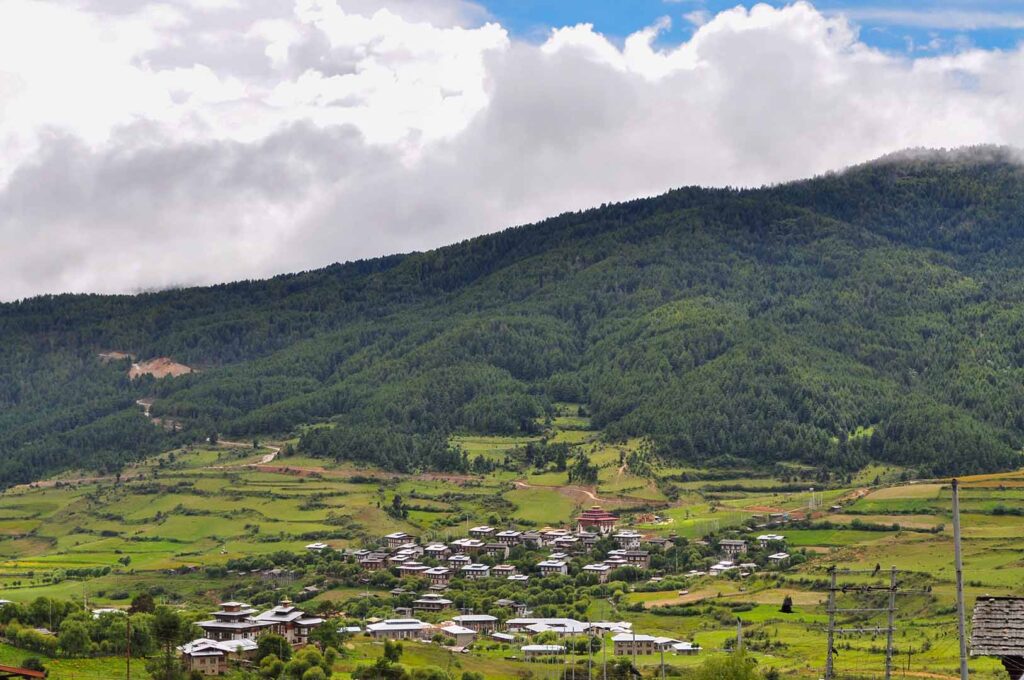
Bhutan in July
This is the time of year when we fully embrace the monsoon season in Bhutan, a prosperous time of year when flowers are in blossom, the valley is clothed with green, weeping willows blanket the sides of several rivers, and pine cones glitter in the sunlight after being filled with resin and poised to fall to the earth. The majority of tourist destinations, including Paro and Thimphu, have typical temperatures that vary from maximums of 25.4 degrees to minimums of 17.9 degrees, with Punakha being the highest with maximums of 29.1 degrees and minimums of 20.1 degrees.
Summer Activities in Bhutan
The most popular Haa Summer festival, short day treks, and cultural tours are among the top things to Bhutan in July. The Haa summer festival is an energetic and upbeat celebration of traditional living culture, nomadic lifestyle, distinctive Bhutanese food, traditional sports, and religious performance. It offers unmatched insights into the way of life of Bhutan’s herders.
Weather, climatology, and rainfall in Summer
Bhutan’s weather is affected by height. Weather conditions in the country’s north, where mountains climb to 7,000 meters, are arctic. Summers are hot and humid.
The monsoon wind sends heavy rain to Bhutan’s southern belt. Central Bhutan, including Paro, Thimphu, Punakha, and Wangdi, had less rain than Southern Bhutan.
Temperature in July
Paro recorded a 25.6-degree high and a 17.6-degree low.
Thimphu 24.8 degrees is high and 15.9 degrees is low.
Wangdue is 27.7 degrees high and 20.8 degrees low.
Trongsa is 26.3 degrees for the high and 18.4 degrees for the low.
Punakha is 20.2 degrees for the low and 29.2 degrees for the high.
Bumthang 22.8 degrees for the high and 14.9 degrees for the low.
Zhemgang 22.6 degrees is high and 18.1 degrees is low.
Rainfall in July
Precipitation varies with the elevation and the average rainfall varies from region to region.
- Himalayan regions are Less than 500mm per year.
- Inner central valleys 500mm to 1,000mm per year.
- Southern foothills are 2,000mm to 3,500mm per year.
- Southern border area 3,000mm to 5,000mm per year.
Would a trip to Bhutan be Recommended in August?
Visiting Bhutan in August and a trip to Bhutan may be exhilarating as the monsoon slowly dissipates and the sky clears to reveal lovely weather. The greatest time to witness Bhutan’s flora is as Bhutan boasts more than 60% of the widespread plant species found in the eastern Himalayas. The abundance of floral species includes 5400 vascular plants, over 500 medicinal plant species, 360 kinds of orchids, 46 species of rhododendrons, junipers, and magnolias.
Events in August
The best activities in Bhutan during August include festival tours, cultural tours, bird-watching tours, cycling, and helicopter tours to explore the Bhutan Himalayas from above. These are the few things you can include on your trip to Bhutan.
List of Bhutan Festival in August.
- Matsutake Mushroom Festival- 15th to 16th August every year in Genekha Thimphu.
- 23 to 24th August Mushroom Mansutake Festival in Ura Bumthang.
- Thrumsingla to Purgeyla Festival from 18th August in Ura Valley Bumthang.
Is September a great opportunity to Travel to Bhutan?
The busiest time of year for travelers to travel is September in Bhutan The months of September and October have the most festivities. The nicest view of the mountains is enjoyed especially by trekkers besides rice harvest brings forth a beautiful scene with amazing terraces and shifting plant colors. The finest months for a Photography tour in Bhutan.
September Travel in Bhutan: 7 Top Activities
- Take on a challenge by taking part in “Tour of the Dragon,” the longest mountain bike race, which spans more than 200 kilometres from Bumthang to Thimphu.
- Witness the most popular Thimphu Festival attended by thousands of locals in the Capital.
- Trek the beautiful Laya Gasa trek starting from Paro and ending at Punakha.
- Join the Bhutan Photography Tour and explore the country via your camera lens.
- Hike the beautiful farms and villages of Bhutan and discover the beauty.
- Hike the beautiful farms and villages of Bhutan and discover the beauty.
- Enjoy the luxury hospitality of an International chain of Hotels like Amankora and Six Sense.
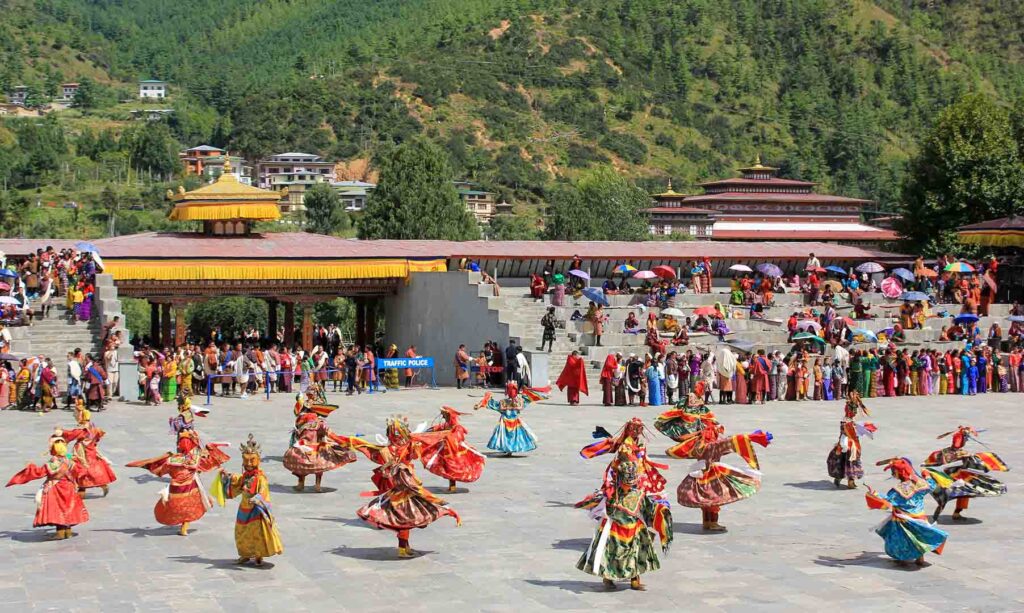
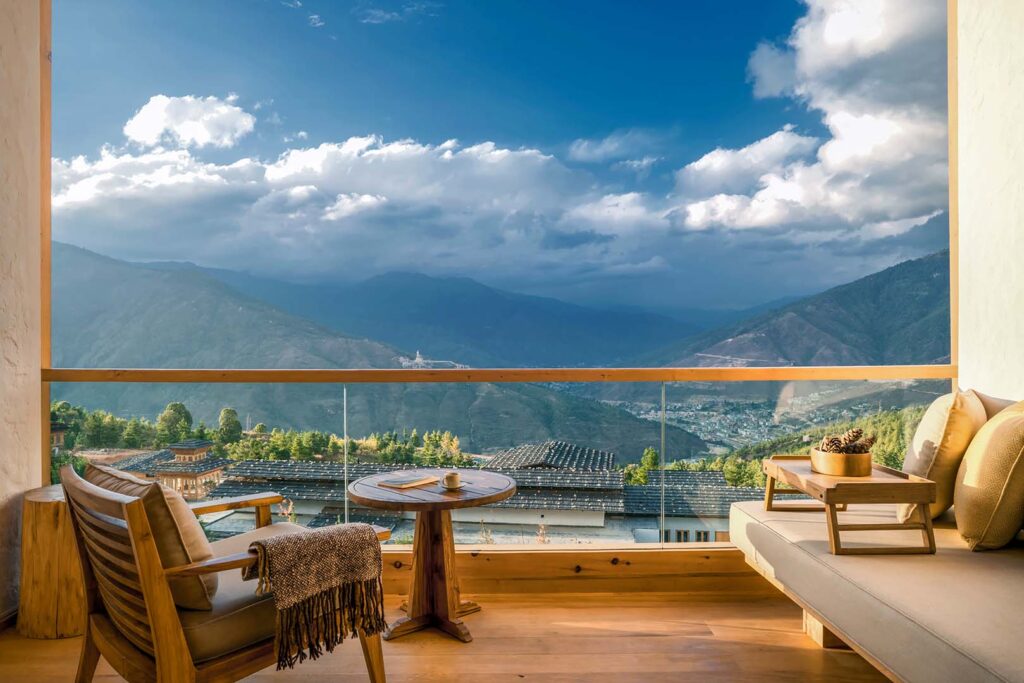
What kind of climate should one expect in Bhutan in September?
The majority of the nation is at a high elevation. The southern portions around the Royal Manas National Park are low and hot in September, with temperatures ranging from 75-88° F (24-31° C). Moreover, the mid-hills are slightly colder, with typical temperatures ranging from 68 to 81° F (20 to 27° C) in Punakha (4250 feet/1300 m). The rest of the country, including Paro, Thimphu, Haa, and Wangdi, has mild weather with highs of 23.8 degrees and lows of 13.6 degrees.
Kindly NOTE: Before settling the visit, if it’s not too much trouble, please check the festival dates.
Top 6 Festivals in Bhutan during September 2024
- Thimphu Dromchhe in Thimphu
- Bum Tashi Festival in Gasa
- Wangdi Festival in Tencholing Army Ground
- Thimphu Festival in Tashi Chhodzong
- Gangtey Festival in Phobjikha
- Thangbi Mewang Festival in Choekar Bumthang
October in Bhutan
October is the best time to visit Bhutan. It illuminates the broad area with a brilliant golden hue. Under the clear blue sky, the rice fields develop a golden brown colour. The area is covered in cheery pink and white cosmos flowers. With around 26.23% of its land area classified as national parks, the country boasts the highest species density (species richness per unit area) in the whole world in addition to placing it among the top ten per cent of all protected areas worldwide. The finest time to explore the national park, go hiking, and take in the unique ambience of Bhutanese festivals.
Best Things to Do in Bhutan in October
Unlike many of the more popular treks provided in Asia, trekking in Bhutan is a distinctive experience. The spectrum of treks includes the straightforward three-day trip from the Thimphu area to Paro and the fabled 25-day trek of the Snowman, which furthermore brings experienced hikers to some of the most beautiful locations in the nation. October is best for such activities.
List of Bhutan Trekking you can do in October
- Druk Path Trek 5 Days. Starts from Paro and ends at Thimphu
- Jumolhari Base Camp trek Starts at Drugyel Dzong and ends at Drugyel Dzong Paro.
- Dur Hot Spring Trek. Starts from Dur in Bumthang and ends at Dur.
- Dongla Trek Starts at Tangma Chu and ends at Trashi Yangtse.
- Dagala Thousand Lake Trek starts at Genekha Thimphu and ends at Genekha Thimphu.
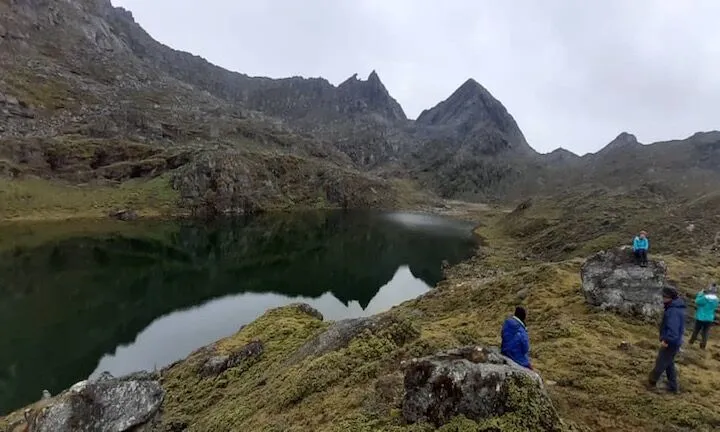
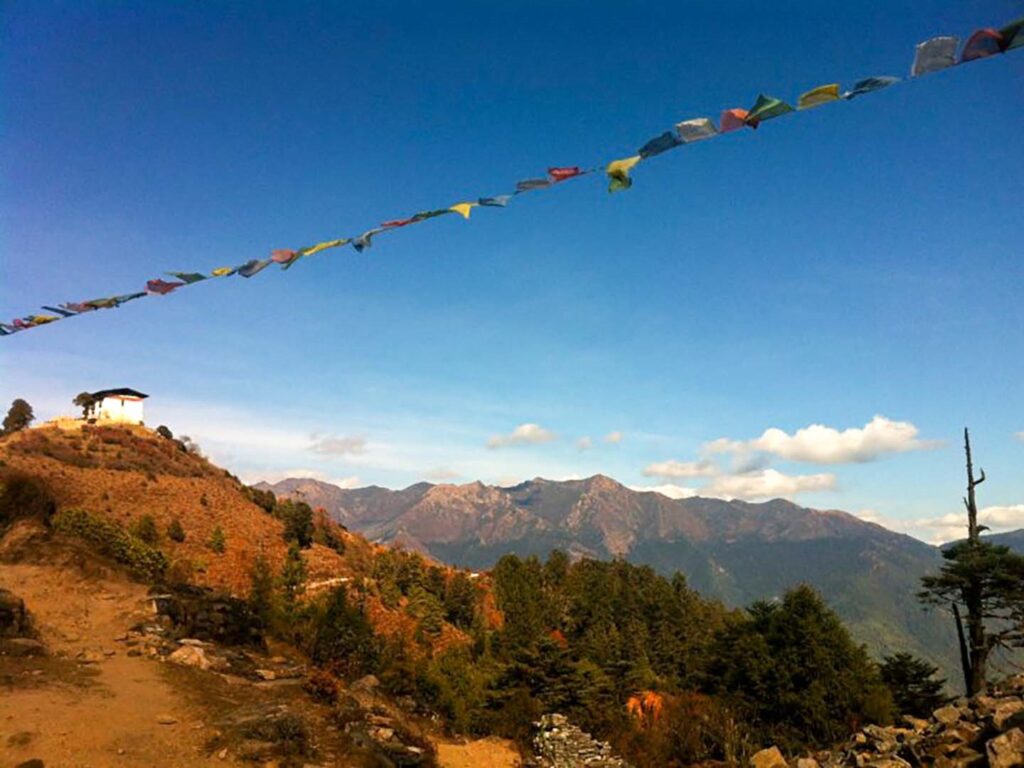
How Hot is Bhutan during October?
The climate varies widely depending on the altitude. Southern Bhutan is warmer compared to other parts of Bhutan. The central valley of Bhutan like Paro, Thimphu, Haa, Wangdiphorang, Trongsa, Bumthang, and Mongar has a semi-tropical climate with cool winters and warm summers. October weather is very favourable in places like Thimphu, Paro Punakha, Wangdi, Haa Trongsa, and Bumthang with maximum temperature ranging from 25.6 degrees to the lowest at 8 degrees.
Tour of the Festival in October 2024
During the event, monks and laymen perform mask dancing in a temple or monastery for three to five days. The Festival concludes with the unveiling of enormous scroll paintings of Lord Buddha, Guru Rinpoche, Zhabdrung, and another enlightened teacher. The centrepiece of the celebration is Joker clutching the phallus dangling from his head because they represent enlightened understanding, and their actions are supposed to purge the collective sin of the people assembled to see the sacred dances.
October 2024 will bring Bhutan’s three most Renowned festivals
- Jumolhari Mountain Festival in Jangothang upper Paro valley
- Jakar Festival in Bumthang.
- Jambhay Lhakahng Festival (Naked Dance Festival) in Bumthang
What could we look into in November?
Bhutan’s hilly environment and rocky topography give great prospects for many types of adventure activities. Hiking, trekking, kayaking, river rafting, mountain biking, and fishing are all options. Mountain biking and bird-watching tours, for example, can be breathtaking in November because Bhutan is home to 800 to 900 species of birds, including some of the most unique and endangered species, such as the imperial heron, which is one of the world’s fifty rarest birds, and the rare Black-necked Crane.
Every year on November 11th, Bhutan conducts the black-necked crane festival for global advocacy. The Black Necked Crane Festival is held at Phobjikha.
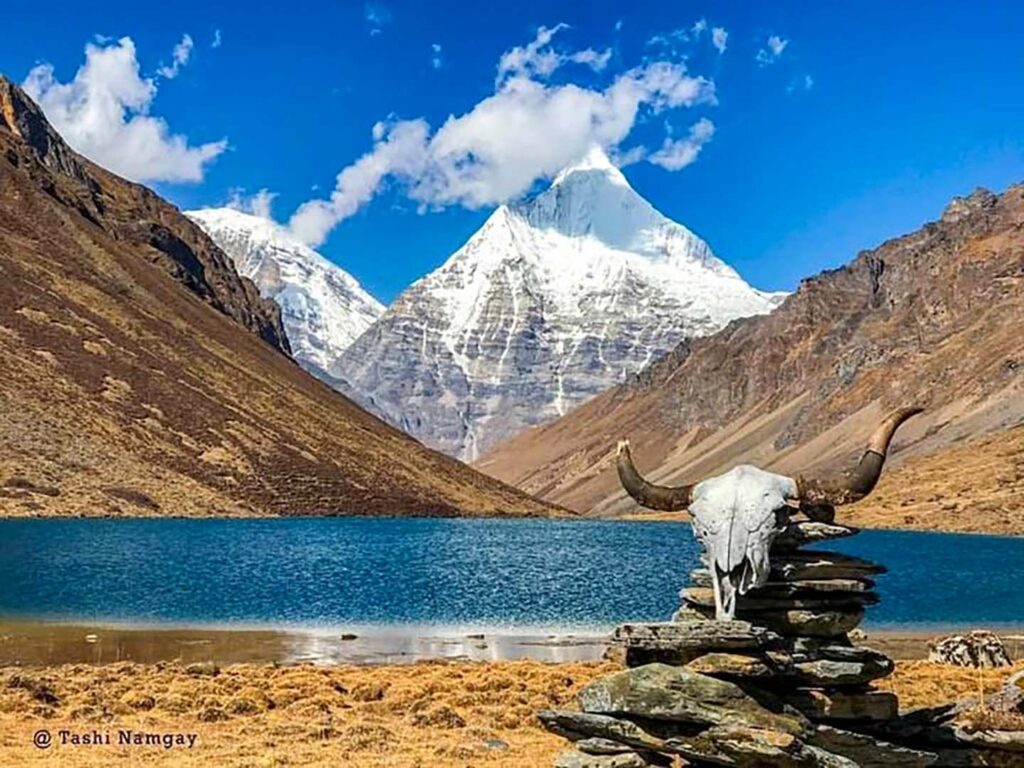
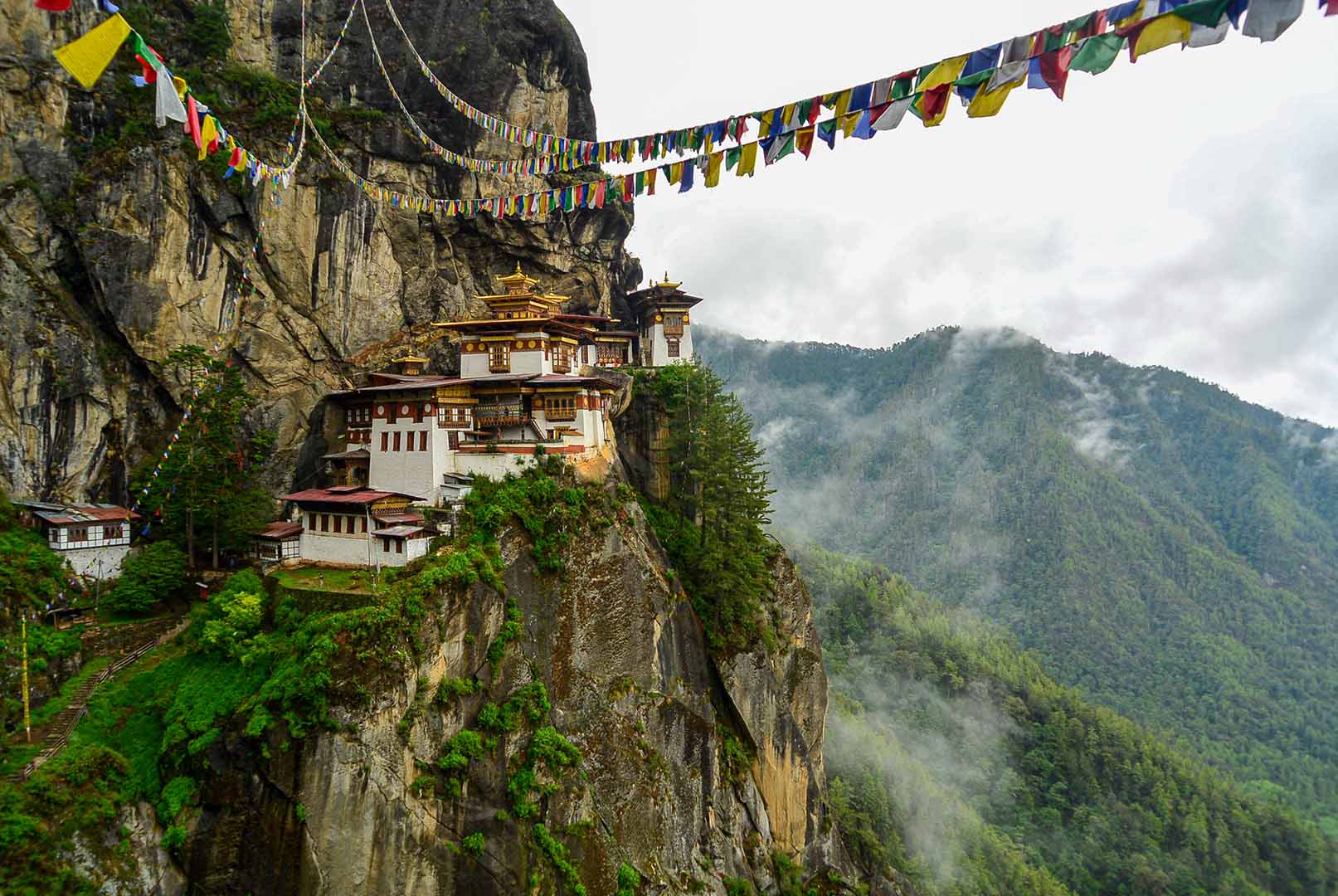
Does it Snow in Bhutan in November?
Low temperatures are expected at night in regions like as Paro, Thimphu, Haa, and Bumthang. The temperature dips to 1°C at night and 16°C during the day. Snowfall is possible on high passes above 4000m, but not in the main city.
Which is the Ideal place to visit in November?
Thimphu, Punakha, Phobjikha, Paro, Trongsa, and Bumthang are the best cities to visit Bhutan in November. Domestic flights are available at Paro International Airport and driving might be difficult owing to ice development on high passes, but the flying experience from Paro to Bumthang is one of the greatest in Bhutan.
Festivals taking place in November
- Black Necked Crane Festival on 11th November at Phobjikha
- Mongar Festival in Mongar Dzong.
- Silambee Festival in Selambee Mongar
- Jambhay Lhakhang Singye Chham in Bumthang
Climate and Weather Conditions in November
November in Bhutan is chilly, and the temperature fluctuates according to the country’s various heights. Heavy snowfall is forecast in northern Bhutan at higher elevations, however, central Bhutan will receive less snow than northern Bhutan.
Paro has a high temperature of 15.8 degrees and a low temperature of 6.3 degrees.
Thimphu had a high temperature of 18.3 degrees and a low temperature of 2.2 degrees.
Punakha, the high temperature is 22.1 degrees and the low is 12.1 degrees.
Wangdiphodrang has a high temperature of 22.4 degrees and a low temperature of 10.5 degrees.
Haa The high temperature is 11.5 degrees and the low is -3.5 degrees.
Trongsa’s high temperature is 19.3 degrees and its low is 9.7 degrees.
The high temperature in Bumthang is 15.1 degrees, and low at 1.6 degrees.
What could you discover in December?
December is chilly in the centre and north of Bhutan, but mild in the south. The days are sunny, while the evenings can get a little cool, but not too cold. The magnificence of the mountains and vast valleys is shown in the winter environment. Clouds hang lazily above mountain peaks, as though waiting for new life to blow them over the landscape. December is the finest month to take a trip because it is the Christmas season.
Climates and Weather in Bhutan in December
The climates and weather differ in each place. Check the temperature of each place below in December.
- Paro- High Temperature 14.0 Degrees & Low Temperature 2.6 Degrees
- Thimphu- High Temp-16.0 & Degree & Low Temp -2.6 Degree.
- Punakha – High Temp 18.9 Degrees & Low Temp 7.5 Degrees.
- Trongsa- High Temp at 18.2 Degrees and Low Temp at 7.2 Degrees
- Bumthang- High Temp at 12.6 degree and Low Temp at -3.6 degree
- Haa- High Temp at 11.5 degree and Low Temp at -3.1 degree
Things to do in Bhutan in December
Bhutan also enjoys a reputation as a Bird Watchers Paradise. The Country boasts 675 species of birds which includes the endangered Black-necked crane that winters in Bhutan. The best thing to do in Bhutan in December is to include an itinerary to watch the Black Necked Crane. Find the best Bhutan Trip in December below.
Places to visit Bhutan in December
The best Western Bhutan, which encompasses Thimphu, Paro, Haa, Punakha, and Wangdiphodrang, is the finest place to visit Bhutan in December. It is also a snowfall season, so you may spend time in the highlands admiring the majesty of snow-capped mountains but visiting Eastern Bhutan might be dangerous owing to ice accumulation on highways, although mountain flights from Paro to Bumthang are always an option.
Top Places to Explore in Bhutan’s Capital
Thimphu, Bhutan’s capital, has a population of 100,000 people. It was designated as the country’s capital in 1961, and it is the country’s largest city. The distance from Paro International Airport is one hour. It hosts the Textile Museum, the Folk Heritage Museum, the Trashichhodzong, the National Memorial Chorten, and the vegetable market, a vibrant market full of local vegetables and handicrafts which are among the best locations to visit in Thimphu. Find More
Best Places to Discover in Paro Bhutan
All travellers travelling into Bhutan on the national carrier Druk Air or Bhutan Airlines arrive in the vast Paro valley. Flight pilots generally advise relieved passengers not to worry if the aircraft wings appear to brush the mountaintop as they conduct a spectacular sweep into Paro town.
The best attractions to see in Paro are the Paro Dzong, the National Museum situated in the Taa Dzong castle, and the popular Tiger Nest Temple. Taktsang Monastery, placed perilously on the rockface of a vertical cliff 900m above the Paro Valley, is one of the most popular spiritual heritage sites. Learn More
Top 4 Places to Check out in Punakha Bhutan
Punakha, Bhutan’s historic capital, is roughly a two-hour drive from Thimphu across the Dochulaa Pass. After passing across the pass, you will descend into the rich and pleasant Punakha valley. Moreover, some of the best places to see are as follows:
- Punakha Dzong
- Chimi Lhakhang
- Khamsum Yulley Namgyel Monastery
- Longest Suspension Bridge
Festivals in December
Festival in Bhutan is celebrated all year round and is a significant occasion for Bhutanese people because it is believed that by attending a festival one can attain merits. Here are some of the essential festivals in December.
NOTE: Please check the festival dates for 2024 and 2025 before confirming the tour.
Bhutan Travel Guide
- Bhutan Flights
- Best Places to Visit in Bhutan
- Bhutan Visa
- Bhutan Trekking Packages
- Bhutan Festival Tour
- Top Hotels in Bhutan
- Gateway to Bhutan
- How to Plan the Bhutan Tour?
- 10 Reasons Why Visit Bhutan?
- Luxury Tours
Bhutan Month-Wise
- Bhutan in January
- Bhutan in February
- Bhutan in March
- Bhutan in April
- Bhutan in May
- Bhutan in June
- Bhutan in July
- Bhutan in August
- Bhutan in September
- Bhutan in October
- Bhutan in November
- Bhutan in December
Bhutan Adventure Travel
- 12 Days Photography Tour
- 9 Days Birding Tour in Bhutan
- 12 Days Wild Manas Tour
- 10 Days Butterfly Tour
Bhutan Cultural Tour
- 6 Days Bhutan Cultural Tour
- 7-Day Bhutan Tour with Home Stay.
- 9 Days Classic Bhutan Tour
- 4 Days Hidden Kingdom Tour
- Bhutan East West Travel
Bhutan Festival Tour 24/2025
Bhutan Luxury Travel
- 12 Days Amankora Journey
- 8 Days Luxury Tours with Six Sense.
- 5 Days Tours with Marriot.
- Classic Bhutan Tour with Uma by COMO.
- 5 Days Pema Ko Holidays
Why Travel with Tour Bhutan?
Tailor Made Experience
All of your ideas/needs will be carefully considered to create your ideal trip.
Worry-Free Planning:
On every step of your planning, we will be available 24/7 to guide you to plan your perfect Holiday in Bhutan.
Guaranteed Bhutan Visa:
We make sure that you get your Bhutan Visa without having to go through lots of Harassment.
Risk-Free Booking
We make sure that we refund as much as possible and adapt to unexpected changes.
Good Accommodation
We booked the best hotel in the city where you can stroll around the place.
Other Useful Information
- Bhutan weather
- Bhutan tourism season
- Bhutan travel season
- Bhutan off-season
- Bhutan monsoon season
- Bhutan winter season
- Bhutan spring season
- Bhutan autumn season
- Bhutan cultural events
- Bhutan festivals
- Bhutan trekking season
- Bhutan flora and fauna season
- Bhutan travel tips.
- The best time to Visit Paro
- The best time to Visit Thimphu
- The best time to Visit Punakha
FAQs for the Best Time to Visit Bhutan
Is there Snowfall in Bhutan?
Snow does not fall in all places in Bhutan. Winter begins in December and lasts until March. During the winter, snow falls in Central Bhutan (Thimphu, Haa, Paro, Bumthang, and Trashi Yangtse) and Northern Bhutan (Gasa).
When is the best time to visit Bhutan on a budget?
To avoid crowds and travel on a budget Bhutan is best visited throughout the summer (June, July, and August) and winter (December, January, and February). In Bhutan, these two seasons are also considered low season, with low daily tariffs and inexpensive hotels.
Which Season is Best for family travel to Bhutan?
The ideal times to visit Bhutan with family are in the spring and autumn. Summer and winter travel is not recommended for families owing to adverse weather conditions. Monsoon downpours in the summer and harsh cold in the winter make spending holidays with family challenging.
What is Bhutan’s average rainfall?
Bhutan’s annual average rainfall (area average) was 1916.29 mm in 2017. Bhutan got somewhat more rainfall than usual, with most areas receiving more rain than usual. Phuntsholing had the most 24-hour rainfall, at 285.4mm.
How long are adequate in Bhutan?
Bhutan is a popular travel destination all year round since it is the last Shangrila and has so much to offer. With so much to see, a 30-day visa extension would be great for a tour of the nation, which could just be long enough to see about two-thirds of all the incredible sites and attractions. The greatest views and experiences of Bhutan must be experienced over at least five days.
How long are tourists permitted to remain in Bhutan?
Tourists can remain in Bhutan for up to 30 days. When Indian nationals arrive, they are given a 7-day pass to visit Paro and Thimphu. They can apply from Thimphu for route permission to enter the restricted districts of Punakha, Haa, Wangdi Bumthang, and Trongsa. They must leave Bhutan after spending 30 days there, and a one-month cooling period is necessary before they may return. Foreigners can prolong their tour for up to 6 months if they can pay US$ 200 per person per day as SDF plus additional money for lodging, transformation, food, and sightseeing and their Visa is granted in advance.
How much does a vacation to Bhutan cost?
A 5-day journey to Bhutan will cost roughly INR 30000 to 45000 for Indian nationals and USD 1040 for international Travellers. The cost is also affected by the season. The high season is more expensive than the low season. March to May and September to November are peak months.
What is the weather like in Bhutan during spring and autumn?
During spring, Bhutan experiences mild temperatures with occasional rainfall. The average temperatures range from 10°C (50°F) to 20°C (68°F). Autumn in Bhutan brings clear skies and cool temperatures ranging from 10°C (50°F) to 25°C (77°F).
Is it advisable to visit Bhutan during the monsoon season?
While some travellers do visit Bhutan during the monsoon season (June to August), it is not considered the best time to go. The monsoon brings heavy rainfall, which can result in road closures, landslides, and limited visibility. However, if you don’t mind the rain and want to experience lush green landscapes, you can still plan a trip during this time.
What are the weather conditions like during winter in Bhutan?
Winter in Bhutan (December to February) can be cold, especially in higher altitude areas. The temperatures can drop below freezing, and some regions may experience snowfall. However, if you enjoy winter activities like trekking or want to witness the unique winter festivals, it can still be a rewarding time to visit.
Are there any specific festivals or events in Bhutan that I should consider when planning a trip?
Bhutan is known for its vibrant festivals, locally called “tshechus.” These festivals are held throughout the year in various dzongkhags (districts) and monasteries. The exact dates vary annually based on the lunar calendar. Some popular festivals include the Paro Tshechu, Thimphu Tshechu, and Punakha Drubchen. It’s recommended to check the festival calendar and plan your visit accordingly if you wish to witness these colourful cultural celebrations.
Is there a particular time to see the famous Himalayan flora and fauna in Bhutan?
Bhutan is home to a diverse range of flora and fauna, including rare Himalayan species. The best time to observe the beautiful rhododendrons and other alpine flowers in bloom is during spring (March to May). Autumn (September to November) is a great time for birdwatching as migratory birds pass through Bhutan. If you have specific wildlife interests, it’s advisable to research and plan accordingly.
Are there any considerations regarding the Bhutanese tourism policy that I should be aware of when planning my visit?
Bhutan has a unique tourism policy that focuses on sustainable and high-value tourism. All visitors, except citizens of India, Bangladesh, and the Maldives, must book their trip through a licensed Bhutanese tour operator. A minimum daily tariff, which covers accommodation, meals, transportation, and a guide, applies to all tourists. It’s advisable to plan your trip well in advance and book through a reliable tour operator to ensure a smooth travel experience.
Can I visit Bhutan during the COVID-19 pandemic?
The COVID-19 situation is subject to change, and travel restrictions may be in place. It’s important to stay updated with the latest travel advisories and guidelines from the Bhutanese government and health authorities. Consult with your tour operator and check the official websites for the most accurate and up-to-date information regarding travel to Bhutan during the pandemic. After WHO declared Covid as not life-threatening Bhutan started accepting tourists who didn’t get any vaccine.
